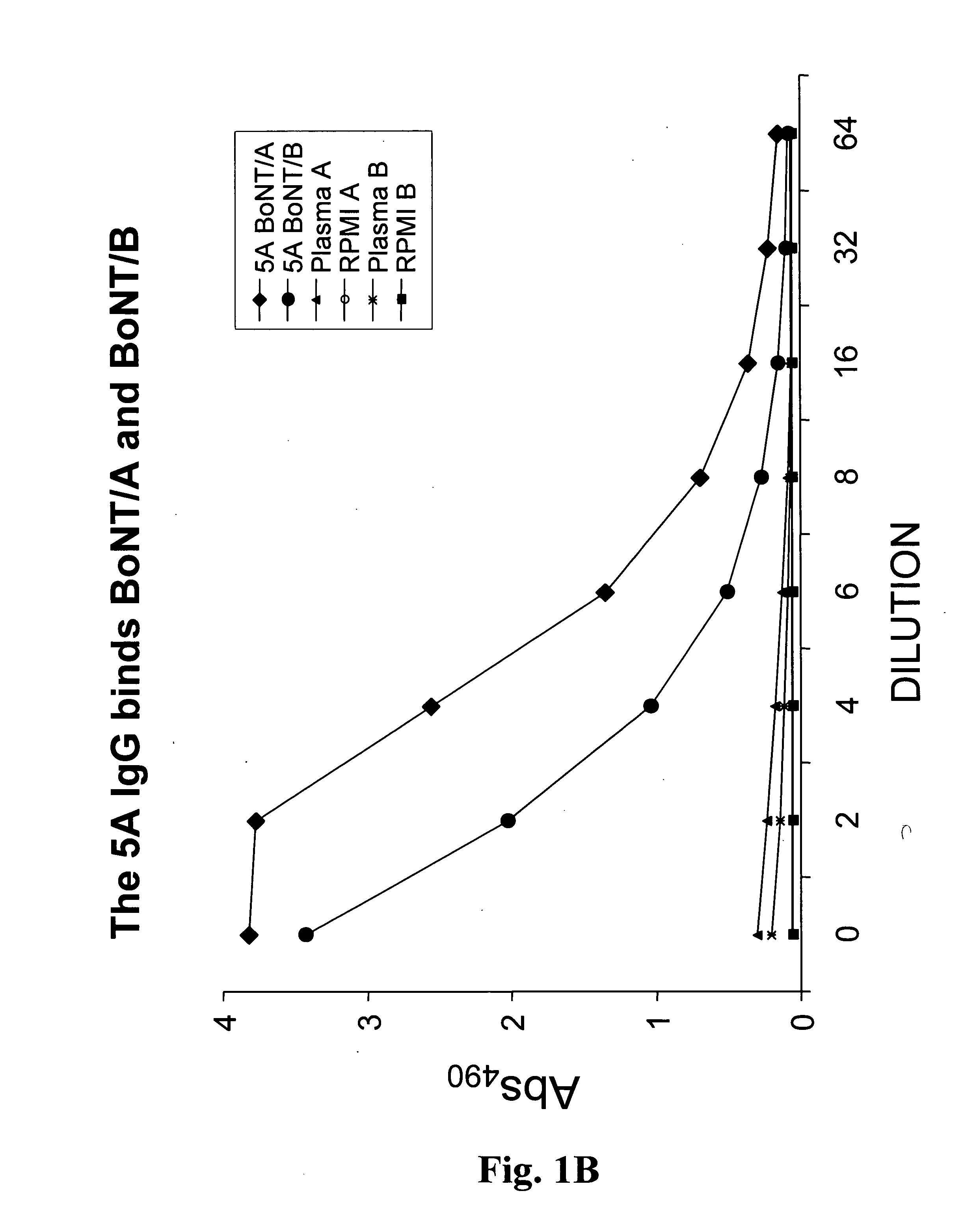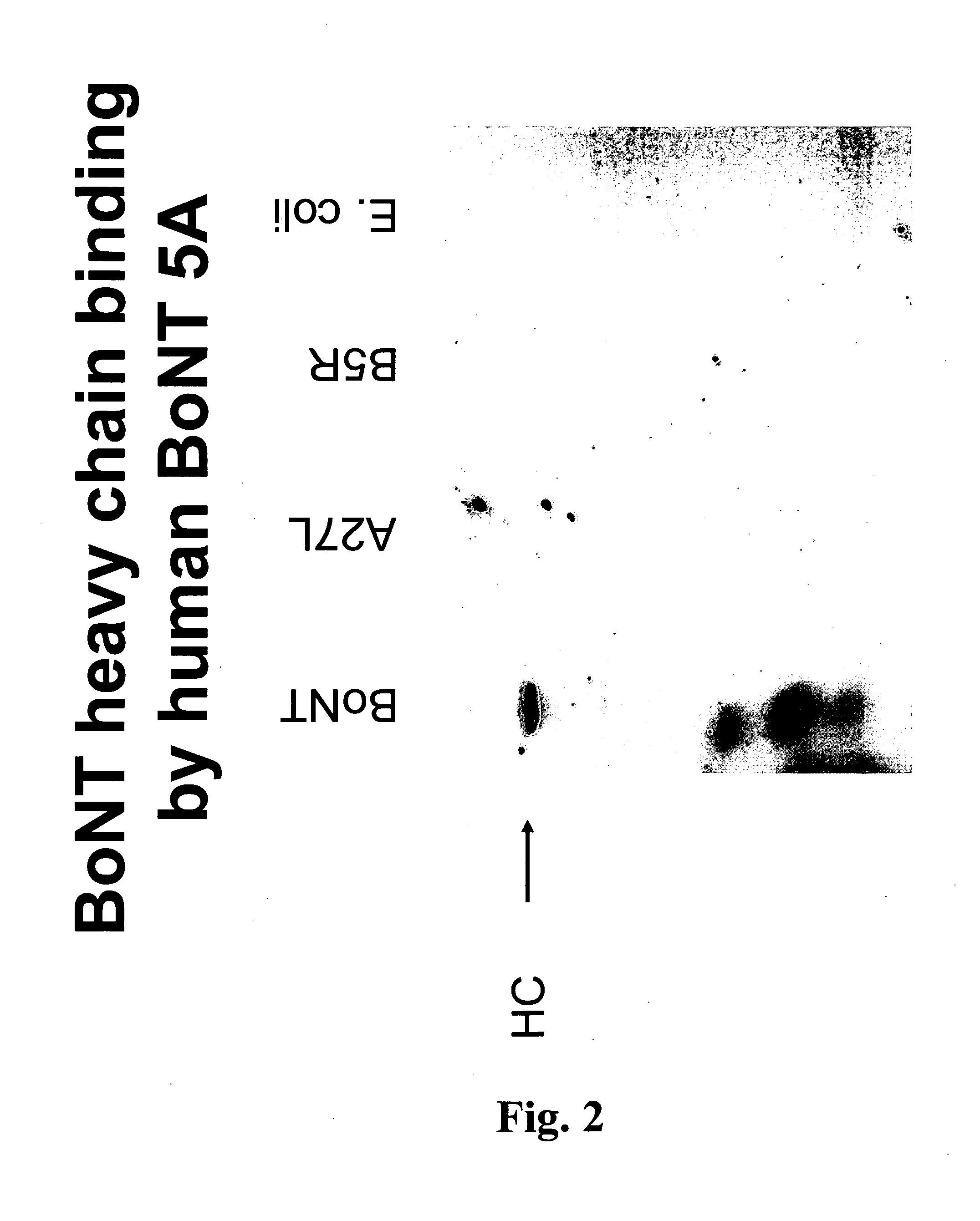Monoclonal antibodies that neutralize botulinum neurotoxin
a technology of neurotoxin and monoclonal antibodies, which is applied in the field of monoclonal antibodies that neutralize botulinum neurotoxin, can solve the problems of limited civilian exposure, the inability to effectively treat patients in intensive care units, and the inability to detect and treat botulinum neurotoxin, so as to reduce the risk of pathology
- Summary
- Abstract
- Description
- Claims
- Application Information
AI Technical Summary
Benefits of technology
Problems solved by technology
Method used
Image
Examples
example 1
Generation of the 5A Hybridoma
[0260]The native human antibody repertoire holds unexplored potential for the development of novel monoclonal antibody therapeutics. Production of a monoclonal antibody includes the fusion of an immortal cell with a primary B-lymphocyte to generate a hybridoma that secretes a monoclonal antibody. A useful cell line for generating a human monoclonal antibody is the SP2 / mL-6 MPT2 cell line, which is a murine cell line that ectopically expresses murine interleukin-6 (mIL-6) and human telomerase (hTERT). It has been demonstrated that such a cell line efficiently forms stable human antibody-secreting hybridomas through cell fusion with primary human B-lymphocytes. The hybrid cells are able to maintain secretion of human antibodies derived from the primary B-lymphocytes through multiple rounds of cloning.
[0261]The cells were cultured using standard methods in the art. For example, confluent cells are split 1:10 into fresh medium Gibco Advanced RPMI with 1% IF...
example 2
Generation of the 70A Hybridoma
[0264]The 70A hybridoma was generated as follows. Peripheral blood lymphocytes from a volunteer donor were stimulated on a CD40 ligand-expressing cell monolayer (tCD40L (Schultze et al., 1997)) with IL-4 (2 ng / ml) for 14 days. The peripheral blood lymphocytes were then fused to the SP2 / mL-6 MPT2 cell line and selected with HAT using standard techniques. Hybrid cell pools were tested for human IgM antibodies secreted into their supernatants that specifically bound BoNT / A by ELISA. Cells in a positive pool were cloned by limiting dilution. A first-round clone was identified as an IgM that specifically bound to BoNT / A (FIG. 3). A representative third-round clone was identified and named 70A-D5.
example 3
Generation of the 50B Hybridoma
[0265]The 50B hybridoma was generated as follows. Peripheral blood lymphocytes from a volunteer donor were stimulated on a CD40Ligand-expressing cell monolayer (tCD40L (Schultze et al., 1997)) with IL-4 (2 ng / ml) for 14 days, then fused to the (c-clone hTERT cell line, a version of SP2 / mL-6 MPT2 cell line that was selected for high mIL-6 expression) and selected with HAT using standard techniques. Hybrid cell pools were tested for human IgM antibodies secreted into their supernatants that specifically bound BoNT / B by ELISA. Cells in a positive pool were cloned by limiting dilution. A first-round clone specifically binding BoNT / B was identified as by ELISA (FIG. 4). A representative third-round clone was identified and named 50B-B8.
PUM
| Property | Measurement | Unit |
|---|---|---|
| Fraction | aaaaa | aaaaa |
Abstract
Description
Claims
Application Information
 Login to View More
Login to View More - R&D
- Intellectual Property
- Life Sciences
- Materials
- Tech Scout
- Unparalleled Data Quality
- Higher Quality Content
- 60% Fewer Hallucinations
Browse by: Latest US Patents, China's latest patents, Technical Efficacy Thesaurus, Application Domain, Technology Topic, Popular Technical Reports.
© 2025 PatSnap. All rights reserved.Legal|Privacy policy|Modern Slavery Act Transparency Statement|Sitemap|About US| Contact US: help@patsnap.com



